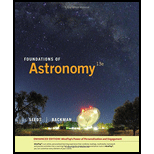
The mass of Saturn, Uranus, Neptune, Earth, and Mercury in terms of mass of Jupiter and distinct them into categories and whether the determination is in agreement with the text.
Answer to Problem 4P
The mass of Saturn is
Explanation of Solution
Refer to Table A-10, “Properties of the Planets” to obtain the value of mass of the Earth as
Write the expression for mass of Saturn.
Here,
Write the expression for mass of Uranus.
Here,
Write the expression for mass of Neptune.
Here,
Write the expression for mass of Mars.
Here,
Conclusion:
Substitute
Substitute
Substitute
Substitute
The masses can be categorized in three categories on the basis of the exponential power.
- 1) Jupiter and Saturn
- 2) Uranus and Neptune
- 3) Earth and Mars
This determination is in agreement with the text.
Therefore, the mass of Saturn is
Want to see more full solutions like this?
Chapter 19 Solutions
Foundations of Astronomy, Enhanced
- 1 m3 of pure water is heated from 10˚C to 120˚C at a constant pressure of 1 atm. The volume of the water is contained, but allowed to expand as needed remaining at 1 atm. Calculate the change in enthalpy of the water. You are provided with the following information at the conditions of 1 atm: The density of pure water between 10˚C and 100˚C: 1000kh/m^3 The heat capacity of water: 4.18 kj/kgK Enthalpy required to convert liquid water to gas (enthalpy of vaporization): 2260 kj/kg The heat capacity of steam: 1.7kj/kgk Is the reaction endothermic or exothermic? Why?arrow_forwardWhen a dilute gas expands quasi-statically from 0.50 to 4.0 L, it does 250 J of work. Assuming that the gas temperature remains constant at 300 K. What is the change in the internal energy of the gas? How much heat is absorbed by the gas in this process?arrow_forwardA high-speed lifting mechanism supports an 881 kg object with a steel cable that is 22.0 m long and 4.00 cm^2 in cross-sectional area. Young's modulus for steel is 20.0 ⋅10^10 Pa. Determine the elongation of the cable.arrow_forward
- Namor, from Wakanda Forever, sits on a throne at the bottom of the ocean in a city called Talocan (and Atlantis in the comics). Assuming he, including his gold headdress, has a density of 1085 kg/m3 and that Namor is surrounded by salt water with a density of 1027 kg/m3, what is Namor’s normal force while sitting underwater? Take Namor’s mass as 285. kg and solve as if he has a uniform density.arrow_forwardTo get there they need to travel through an area of salt-water, which seems to also be a magical portal, before arriving in a dry area. Judging by the time Maui and Moana spend falling through the water, it seems they dive 3440. ft deep. Assume the portal is non-magical salt-water, with a density of 1027 kg/m^3. Given that the air pressure above the portal is 1.013 ⋅10^5 Pa, what is the pressure when they are 3440. ft deep? 1 m = 3.28 ft. Moana would have a surface area of 1.30 m2. How much force would be acting on her at the bottom of this portal?arrow_forwardA plank 2.00 cm thick and 15.7 cm wide is firmly attached to the railing of a ship by clamps so that the rest of the board extends 2.00 m horizontally over the sea below. A man of mass 92.9 kg is forced to stand on the very end. If the end of the board drops by 5.97 cm because of the man's weight, find the shear modulus of the wood.arrow_forward
- when considering particle B (4,1) distances in relation to P (-4, 5), why are the y coordinates being used gto resolve the distance along the x-axis and vice-versa?arrow_forwardA 198 kg load is hung on a wire of length of 3.58 m, cross-sectional area 2.00⋅ 10-5 m2, and Young's modulus 8.00⋅10^10 Pa. What is its increase in length?arrow_forwardI. Pushing on a File Cabinet Bob has been asked to push a heavy file cabinet down the hall to another office. It's not on rollers, so there is a lot of friction. At time t = 0 seconds, he starts pushing it from rest with increasing force until it starts to move at t = 2 seconds. He pushes the file cabinet down the hall with varying amounts of force. The velocity versus time graph of the cabinet is shown below. A. On the graphs provided below, 1. draw the net force vs. time that would produce this velocity graph; 2. draw the friction force vs. time for this motion; 3. draw the applied force (Fon Cabinet by Bob) VS. time for this motion (the first two seconds of this graph have been drawn for you). Velocity (m/s) Applied Force (N) Friction Force (N) Net Force (N) A -m B -U time (s) D time (s) time (s) time (s)arrow_forward
 Foundations of Astronomy (MindTap Course List)PhysicsISBN:9781337399920Author:Michael A. Seeds, Dana BackmanPublisher:Cengage Learning
Foundations of Astronomy (MindTap Course List)PhysicsISBN:9781337399920Author:Michael A. Seeds, Dana BackmanPublisher:Cengage Learning

 AstronomyPhysicsISBN:9781938168284Author:Andrew Fraknoi; David Morrison; Sidney C. WolffPublisher:OpenStax
AstronomyPhysicsISBN:9781938168284Author:Andrew Fraknoi; David Morrison; Sidney C. WolffPublisher:OpenStax Stars and GalaxiesPhysicsISBN:9781305120785Author:Michael A. Seeds, Dana BackmanPublisher:Cengage Learning
Stars and GalaxiesPhysicsISBN:9781305120785Author:Michael A. Seeds, Dana BackmanPublisher:Cengage Learning An Introduction to Physical SciencePhysicsISBN:9781305079137Author:James Shipman, Jerry D. Wilson, Charles A. Higgins, Omar TorresPublisher:Cengage Learning
An Introduction to Physical SciencePhysicsISBN:9781305079137Author:James Shipman, Jerry D. Wilson, Charles A. Higgins, Omar TorresPublisher:Cengage Learning





